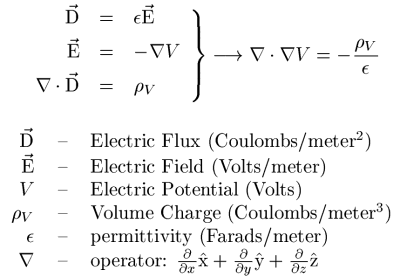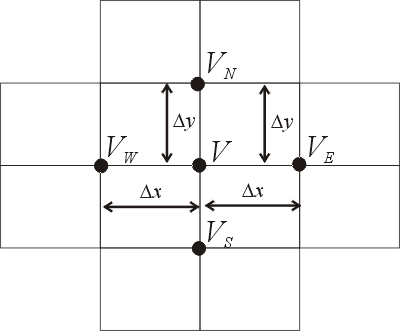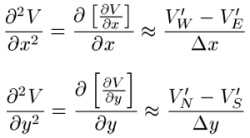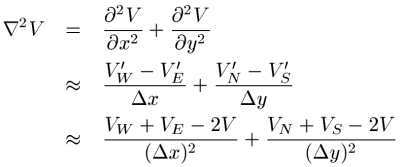|
|
|
Poisson and Laplace's Equation |
|
By combining our dielectric
material relationship, our definition of electric potential, and
Maxwell's electrostatic equation, it is possible to derive a
differential equation that relates space-varying voltage to the volume
charge density of space: |
|
 |
|
In words, this equation
states the following: the divergence of the gradient of voltage
is proportional to the charge volume density at every point in space.
The operation involving the divergence of the gradient of a scalar
function has a special name in the physical sciences; it is called the
Laplacian. Thus, we could restate this equation in the
following words: the Laplacian of voltage is proportional to
charge volume density. The Laplacian operator occurs so
frequently in electromagnetics and other fields that it has its own
short-hand notation:  . The
Laplacian operator for voltage is defined as follows: . The
Laplacian operator for voltage is defined as follows: |
|

|
|
Although the Laplacian has a
compact, elegant form, it defines a multivariable partial-differential
equation that can be quite difficult to solve. |
|
The equation that relates the
Laplacian of voltage to electrostatic charge has two names, depending on
the presence of charges. Poisson's equation is the name of
this relationship when charges are present in the defined space.
To solve Poisson's equation, we require two pieces of information about
the solution region of space: 1) voltage boundary conditions and 2) the
charge distribution. Laplace's equation is the name of this
relationship when there are no charges present and only requires
information about voltage boundary conditions. Thus, the two forms
of this equation are |
|
 |
|
In this discussion, we will
be focusing on the numerical solution of Laplace's equation, although it
is very easy to extend the results to Poisson's equation. |
|
|
|
Discrete Laplace's Equation |
|
There are very
few examples of electrostatic problems that can be solved using the
analytic form of Laplace's equations. Fortunately, we can recast
Laplace's equation so that it is solved by a computer. This
requires us to sample space, calculating the voltages in a region only
at a finite number of discrete points. If we model these points
accurately, then we approximate any voltage in between them through the
use of interpolation. |
|
For the purposes
of this discussion, we will use a rectangular grid to sample the voltage
in two-dimensional space. An example of this 2D sampling is shown in Figure 1. The
rectangular grid geometry is extremely easy to calculate and translate
into a computer array of voltages. There are actually many other
types of sampling schemes for Laplace's equation that are optimized to
certain types of problems. Finite Element Method (FEM), for
example, allows the engineer to sample space with non-uniform nodes; for
FEM, regions of space that experience bigger changes in voltage receive
denser samplings than regions of space with slow-varying voltages.
In this way, FEM places samples in space "where they do the most good", minimizing
the computation time of very large problems. |
 |
|
Figure 1: A uniform, rectangular network
is used to sample Voltage in two-dimensional space. From these
discrete samples, we must estimate partial derivatives in x and
y. |
|
There are very
few examples of electrostatic problems that can be solved using the
analytic form of Laplace's equations. Fortunately, we can recast
Laplace's equation so that it may be solved by a computer. To do
this, we must find a way to approximate the second partial derivatives
of voltage using our discrete samples in space. Referring to
Figure 1, if we want to approximate the first partial derivative
of voltage at a point in space, we can construct an expression based on
its neighboring voltages: VN, VS, VE,
and VW (North, South, East, and West). In fact, for the
partial derivatives of voltage with respect to both x and y,
there are two possible approximations we can use for each: |
|
 |
|
These approximations follow
very logically from the definition of a partial derivative: they mark
the change in voltage in the x or y direction, divided by
the spatial increment that separates the samples. Thus, we have
two possible expressions for partial derivative with respect to x
(which we will call VE' and VW') and two possible
expressions for partial derivative with respect to y (which we
will call VN' and VS'). |
|
Now that we have
approximations for the first partial derivatives, we can construct
approximations for the second partial derivatives as well, based on the
ideal that a second partial derivative is simply a "derivative of a
derivative". Thus, we can use the difference between VE'
and VW' to estimate the second partial derivative in the x
direction; we can use the difference between VN' and VS'
to estimate the second partial derivative in the y direction.
The equations for this are given below: |
|
 |
|
Now we have enough
relationships to construct a discrete version of Laplace's equations in
two dimensions. Substituting these values into the definition of
the Laplacian gives us: |
|
 |
|
It is this last term that, in
the absence of charges in space, must be set equal to zero. |
|
The most convenient choice of
spatial increments is the case of Dx=Dy, which represents sampling on a
square grid. Under these circumstances, the discrete form of
Laplace's equation becomes: |
|
 |
|
This equation is actually
very simple: it states that a voltage at any particular point in
uniformly sampled space must be the average of its nearest neighbors. So
the discrete form of Laplace's equation is actually a 2D network of
simple, interconnected averaging equations. Therefore, an M
x N grid of voltage samples will produce MN discrete
equations that can be solved iteratively by a computer. There is
an online example in this tutorial that
discusses how to solve the discrete Laplace equations as well as some
Matlab code for solving and graphing the
solutions to interesting 2D voltage calculations. |
|
You do not really need to
have complicated computer codes to solve Laplace's equation. In
fact, you can solve Laplace's equation very easily using only a
spreadsheet! Simply put this averaging formula in a grid of cells,
surround the cells with boundary conditions, and then iterate the
calculation until the voltage values appear to converge to a final
answer. |
|
|
| |
|
|
|
|
